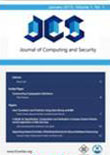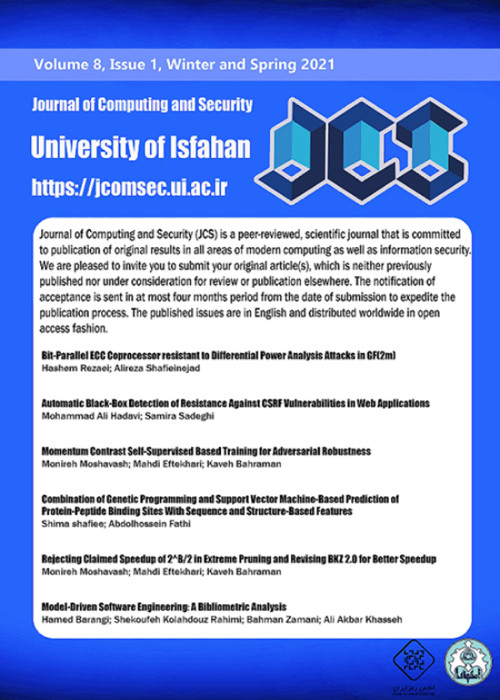فهرست مطالب

Journal of Computing and Security
Volume:3 Issue: 1, Winter 2016
- تاریخ انتشار: 1394/12/18
- تعداد عناوین: 6
-
-
Pages 3-12In 2003, Waters, Felten and Sahai introduced a novel cryptographic primitive called Incomparable Public Key cryptosystem to protect anonymity of message receivers in an untrusted network. In this setting, a receiver is allowed to create many anonymous identities for himself without divulging the fact that all these identities refer to the same receiver. Recently, Lee and Lim improved the solution of Waters et al. with a more efficient decryption process. Both of these schemes are based on the ELGamal encryption scheme and are CCA1-secure in the sense of data privacy and IK-CPA-secure in the sense of key privacy. In this paper, we employ the Cramer-Shoup encryption scheme to propose the first example of an incomparable public key encryption scheme which is CCA2-secure in data privacy and IK-CCA-secure in key privacy. Therefore, our scheme outperforms existing incomparable public key schemes in security properties.Keywords: Public Key Encryption, Anonymity, Key Privacy, Data Privacy, Incomparability
-
Pages 13-26Block ciphers have wide applications for hardware and software implementations. In this paper, a new block cipher algorithm with provable security is proposed. The whole structure of the algorithm is novel and has a good encryption and decryption performance. Additionally, it has good security with few number of rounds. The structure of the proposed algorithm consists of 4-rounds Feistel-Like which uses 3-rounds Feistel type functions. Moreover, a new method for MDS (Maximal Distance Separable) Matrix construction is proposed and used in the round function as a linear layer. Furthermore, some considerations in S-Boxes of the algorithm lead to obtaining better algebraic expression than AES S-boxes. The Algorithm has a high margin of security against various cryptanalysis methods due to using specific functions in its round functions. Our theoretical evaluations show that the devised cipher algorithm has provable security against attacks based on linear and differential cryptanalysis and it is robust against differential, truncated differential, boomerang, and integral cryptanalysis in terms of practical security.Keywords: Cryptography, Cryptanalysis, Practical Security, Provable Security, Cipher Algorithm
-
Pages 27-42This paper presents the hardware simulation (based on VHDL code) of a multiple-fault tolerant cellular genetic algorithm. This study aims to increase the immunity of cellular genetic algorithm in a multiple-fault situation. Here, multiple-fault refers to the situation that SEU (single event upset) occurs simultaneously at two or more bits of the chromosome and fitness registers. The fault model includes simultaneous bit inversion in chromosome strings and the worst case stuck faults in fitness registers. The main idea of the proposed approach is to control the trade-off between exploration and exploitation in fault recovery phase. The achievements of this experiment are novel recovery strategy due to applying CRC encoding and a new scheme in connections of processing elements. In order to show valid results, the algorithm is tested with four benchmarks in various fault situations based on popular evaluation metrics. In experimental results, two topologies (two and three-dimensional) of suggested MFT-cGA are evaluated. To illustrate the achieved immunity and improvement, the proposed MFT-cGA is compared with the canonical version of cGA. The whole results show that the proposed architecture is able to handle multiple-faults with up to 100% of faulty processing elements.Keywords: Cellular Genetic Algorithm, Fault Tolerance, Single Event Upset (SEU), Processing Element (PE)
-
Pages 43-52Estimating similarity is expressed in many domains and sciences. For instance, data mining, web mining, clustering, search engines, ontology mapping and social networks require the definition and deployment of similarity. User similarity in social networks is one of the main problems and has many applications in this area. In this paper, a new method is introduced for combining structural and non-structural similarity between users in social networks. In the experimental section, structural similarity algorithms are combined with non-structural similarity algorithms through the proposed method. All experiments are implemented on some part of the Twitter dataset. Experimental results show that the precisions of all algorithms are increased with the proposed method.Keywords: Social Networks, Structural Similarity, Non
-
Pages 53-62Augmented Reality (AR) has introduced new forms of interaction and presentation in mobile applications. Mobile games have also taken the advantages of this technology to implement novel techniques for interaction between players and game objects. This paper aims to study the effect of AR technology on the sense of immersion and quality of experience in mobile games. In particular, we compare Virtual Reality (VR) camera with AR camera in terms of enhancing the sense of immersion and quality of experience in mobile games. A comprehensive user study is performed to find if there is a significant difference in the sense of immersion between the players using these different cameras. We also analyze how the quality of experience is affected by this parameter.Keywords: Sense of Immersion, Augmented Reality, Mobile Games, Quality of Experience
-
Pages 63-72Considering the dynamic and wireless topology of the mobile ad hoc networks (MANETs), the implementation of security in such networks is an important problem. Key revocation is a solution for this challenge which prevents the continuous presence of the attacker in the network and disclosure of confidential information.
In some suggested key revocation protocols such as Liu et al.'s scheme, each node monitors the network and will send an accusation packet to the authority center if it receives a suspicious behavior from the neighboring nodes.Then, the authority center decides to revoke the key of the accused node based on the number of received accusations. Due to the fact that the participation of the nodes is time consuming, the threshold for the number of accusations is an important factor for key revocation procedure. In this paper, a stochastic model is presented to determine the optimal threshold for the number of accusations and the appropriate time for decision making in the key revocation protocol. Based on some assumptions, the threshold parameter is used in key revocation scheme of Liu et al. and results are evaluated by simulation. Simulation results show that the proposed threshold for the number of accusation packets enhances the efficiency and effectiveness of the key revocation protocol for MANET.Keywords: Ad Hoc Network, Key Revocation, Accusation Packet, Key Management


